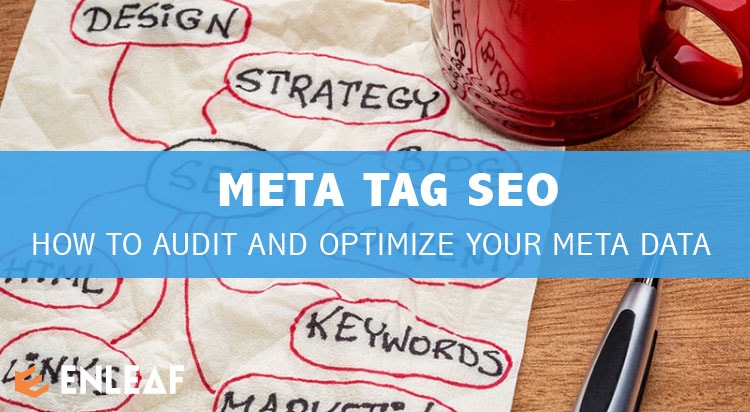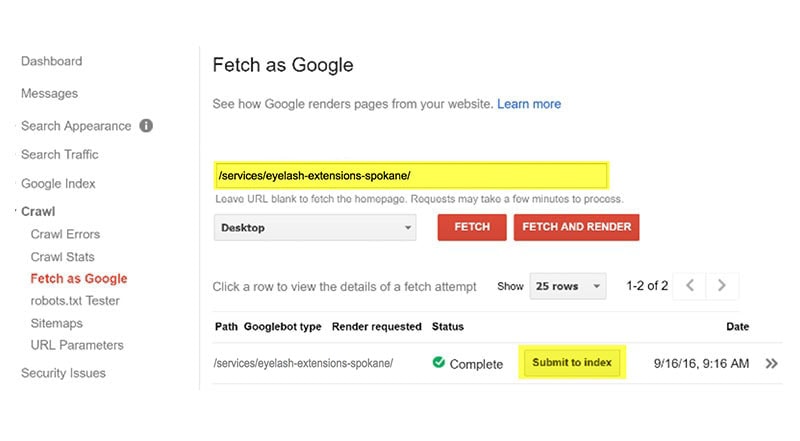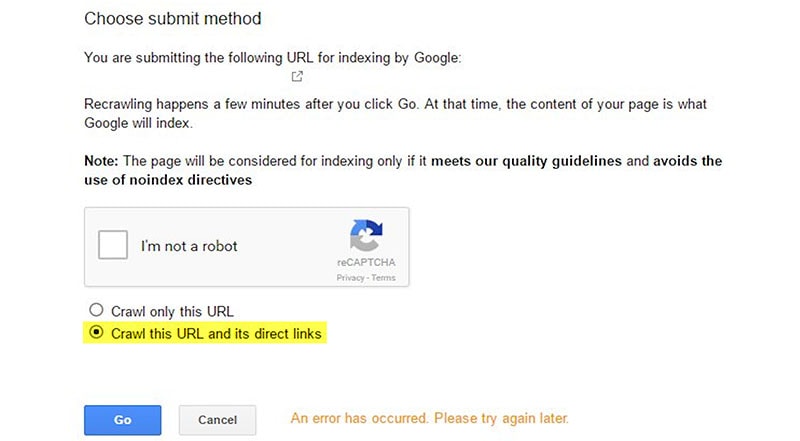
Meta Tags SEO – How to Audit and Optimize your Meta Title and Description
Meta Tags SEO is an aspect of digital marketing that never seems to diminish in importance. This should not come as too much of a surprise as properly written meta descriptions can help improve a site’s search visibility, thereby resulting in more click-throughs and conversions. But before elaborating further on how to optimize your metadata, it’s probably a good idea to start with the basics and explain what meta titles and meta descriptions are how they are used.
What is Meta Data
 What are meta titles?
What are meta titles?
Located in the head of a document, a meta title is a title that a web page presents in the uppermost section of the search engines results so that when a person is searching for content they’re able to reference and link to the page from the SERP.
What are meta descriptions?
Meta descriptions are ~160 characters snippet that provides a concise overview of what a web page is about. It is placed in the HTML of a web page and appears underneath the blue clickable links in a SERP (Search Engine Results Page).
Why Crafting Them Is Important For SEO

Despite announcements from search Giant Google that they don’t directly influence the ranking of a web page, meta titles and meta descriptions remain a vital part of on-page optimization. The link between search rankings and meta description can be summarized as follows;
1. A meta description is important for enhancing click-throughs.
Google considers user behavior, and as such, writing compelling meta titles and descriptions will lead to more click-throughs thereby leading to better rankings. See, Google ranks sites depending on the number of people clicking on those SERP titles, and the more people clicking them the higher the rankings Google will give a site.
2. Click through rate is one of the Googles algorithmic ranking factors.
According to an article written by Pete Meyers of Moz, click-through rate (CTR) and the time a user spends on a site are among the most important elements in a site’s ranking. For instance, Google and Bing’s first clues on whether or not a given result is relevant or not to a query are dependent on the CTR. Needless to say, relevant results lead to more clicks and the more clicks the better the rankings will turn out to be.
3. User behavior is a search engine algorithm factor.
As you probably already know, search engines use hundreds of algorithmic factors to rank a site. Google even uses demographic information to better offer relevant SERP’s to users. For example, a user located in Anchorage Alaska will have different results presented when searching for the local weather forecast then say a person searching for the same term in South Carolina.
Now that that you have some background on what meta titles and meta descriptions are it’s time to learn how to audit and optimize them for better click through rate. To do this we are using a Google Search Console
Don’t have the Google Search Console installed? See the great tutorial from brucecaly.com here.
How To Audit Your Meta Data
Step #1
- Within Google Search Console, go to Search traffic > Search Analytics
- Select Clicks, Impressions and CTR (Click Through Rate) and make sure the Queries filter is selected.

Step #2
Then set your date range out far enough to get a good sampling of data. ( I usually go with 90 days. )
This will give you a list of each of your pages by clicks and impressions and CTR.
What we are looking for here are keywords that have a lot of impressions but few clicks.
( To keep it simple scan for terms that have a CTR of 5% or lower.)
Step #3
Once you have identified a keywords with a lower CTR to impression ratio, click on the arrows icon to pull the page or pages that are being found with that keyword.

In this example, there are 3 pages that are being retrieved for our keyword.
(The top result in particular is one we want to look at, as it’s traffic generating keyword and the page subject matter are similar.)

Step #4
From here you want to head over to Google and do a search for your keyword.

This should pull a list of results including your pages title and description.
(It’s a good idea to review both your listing and your competitions listing to inspire ideas for copy variations that will improve your CTR)

Once you have some ideas of how to add to or improve your page title and description you will want to update the meta data on your website.
(Don’t know how to do that? We can help)
Step #5
Writing Meta Descriptions and Titles That Rock The SERPs
Here are a few suggestions for writing impactful meta titles and meta descriptions.
- First, it’s important to make sure they concisely articulate your value proposition.
- Be mindful of the intent of the user when writing the meta description.
- The way the meta descriptions are written should portray the specific value that the user expects to see when they click through to your web page.
- A better way to guarantee that your value proposition is relevant to your landing page is to do some side-by-side comparisons to evaluate what your page descriptions are saying.
Meta Title:
Make sure that your keyword shows up in the front end of the title tag
Meta Description:
Make sure that your meta description is as relevant and compelling and matches the content and theme of both your landing page copy and keyword.
Keep It Equal or Less Than 155 Characters
Although the meta description guideline allows for 150-160 characters, aiming for 155 characters or less will help you avoid awkward mid-sentence breaks that you will often encounter should you go for the maximum character length.
(A good tool for this is http://www.seomofo.com/snippet-optimizer.html)

Incorporate a Call-to-Action Message
Let’s face it, the meta descriptions for your website are basically ads competing with others in the SERPs. So, what do you do to attract click-throughs in the face of stiff competition? The simple answer would be to incorporate a short call-to-action or offer towards the end of the meta description. Call-to-action (CTA) have been proven to be a great yet simple way to improve click-through rates.
Be Mindful of Competition from Google AdWords
Depending on the keyword, some search results can have up to 4 listings with Google AdWords getting a prime chunk of the real estate. As such, it is necessary to rank higher in the organic SERP listings in order to capture most click-throughs. A more helpful and inviting meta description will better ensure that even with ad populated SERPS, your web page will still have a size-able amount of click-throughs.
Use the Right Words That Inspire Curiosity
Words used in the meta description and title tag should not only match what the user is looking for but should also inspire curiosity. It goes without saying that a user needs to see relevant words in order for them to be compelled to click. Words that have the right combination and arouse curiosity make the difference between a SERP entry that gets clicked and one that gets overlooked.
Words to include into your title tag that are shown to increase click through rate.
- How
- Free
- You
- Tips
- Great
- Tricks
- Best
- Why
- Blog Post
- List (Top 10, 5 Most..)
Test, Monitor & Adapt
It’s key to test, monitor and adapt anything that you do with your marketing and website efforts, and this should be based on what has a proven track record of working for you. As a content publisher, you shouldn’t be afraid to experiment with different variations and then eventually choosing what works.
Step #6
Once you have made changes to your meta titles and meta data, you will need to have Google re-crawl the updated web page. To do this go back to Google Search Console and go to Go to Crawl > Fetch as Google
(If the change was made to your home page then you simply need to hit Fetch and Render. However if the change was made to an internal page you will need to (Blog Post, About Us Page, Etc) you will need to put the URL path into the open filed. Then click Fetch and Render)
Step #7
Then you will need to hit the submit to index button
Step #8
Then we want to select the second option crawl this URL and its direct links.
Step #9
After 30 days you can repeat the processes taking note of the effect on your keywords CTR.
Ultimately if your updated title and description are more compelling you would see some improvement in your CTR.
Conclusion
In the end, meta descriptions and title tags are key elements in your overall SEO efforts. They are the only things that stand between a visitor and a search result. Needless to say, well-written title tags and meta descriptions are a sure win in the SERPs and act as a welcome mat to your potential visitors. And the more the click throughs you get to your site the better search engines will rank your site. Also, it is important to back your meta descriptions with high quality content on your webpage.




